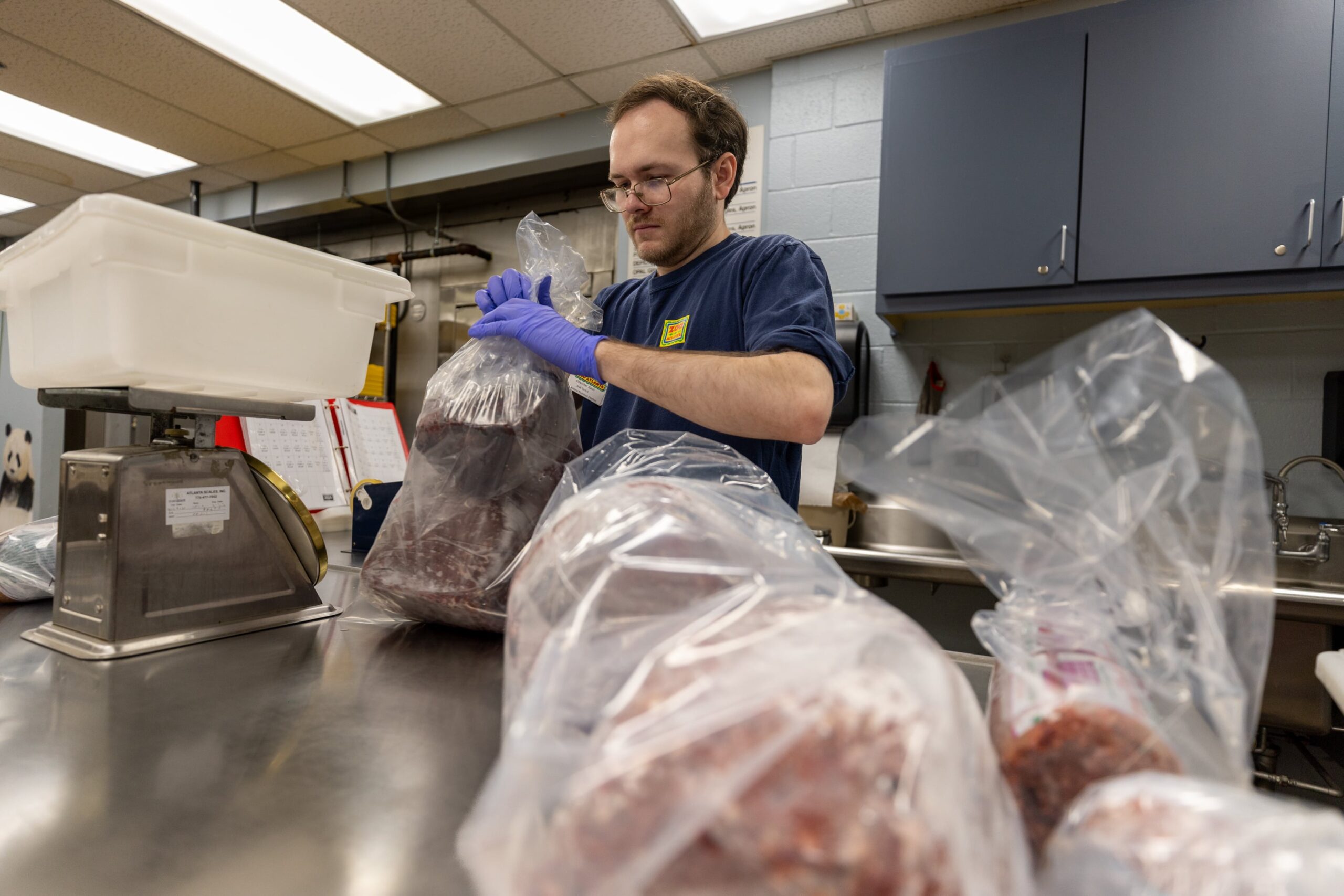It looks like the kitchen of any restaurant getting ready for a noon rush. It’s not.
A group of managers, nutrition technicians, bamboo hunters, and other employees collaborate in the animal nutrition kitchen, which is located in the rear of Zoo Atlanta, to make meals and snacks for the more than 1,300 animals that call it home.
Each of the more than 220 species represented by those animals has distinct nutritional requirements. It takes ingenuity to replicate their natural diets in an Atlanta kitchen. Verifying that the right nutritional balance has been attained through animal observation and monitoring is equally crucial.
Nutrition sleuths
A baby golden-breasted starling caught the attention of zookeepers a few years ago. The legs of the bird were starting to take on an odd form.
After taking the bird for X-rays, Dr. Sam Rivera, Zoo Atlanta’s vice president of animal health, concluded that it had weak bones. He gave the nutrition kitchen at the zoo instructions to increase the bird’s daily feed with calcium and vitamin D. The legs of the bird started to acclimate correctly after a few weeks.
Another time, zookeepers saw a herd of goats experiencing dramatic weight loss.
One problem with nutritional imbalances or shortages is that they can impact entire populations if a group, such as a family group of gorillas or a flock of birds, is given the same diet, according to Rivera.
[email protected] is credited.
[email protected] is credited.
For instance, the goats mostly ate hay as their food. For nutritional analysis, Rivera sent a sample of the zoo’s most recent delivery of hay to an outside laboratory.
The proportions of fiber, protein, and trace minerals in hay can change during the year or as a result of various growing environments. According to the test, the hay did not meet Zoo Atlanta’s requirements. The goats’ bellies regained their natural roundness once the hay was swapped out for a better quantity.
A zookeeper’s duties include this kind of dietary detective work.
“If you notice something wrong with an animal, keepers are the first line of defense,” Rivera added. Every day, they observe the animals to look for changes in energy levels, hunger, behavior, weight, or stool quality. They observe gradual alterations that could point to a long-term dietary excess or deficit.
According to Rivera, there may be severe repercussions if a nutritional deficit is not identified.
This may cause appropriate therapy to be delayed. According to Rivera, in extreme circumstances, it may result in irreparable harm or even death.
When an issue is identified, Rivera collaborates with the nutritional kitchen at the zoo to modify the animal’s diet by adding supplements, switching brands, or modifying recipes.
Therefore, the nutrition kitchen at Zoo Atlanta plays a crucial role in producing the wholesome, well-balanced food that is necessary for animal health, breeding, conservation, and public enjoyment.
[email protected] is credited.
[email protected] is credited.
Behind the scenes
Calendars and recipes that Rivera helped create are kept in binders on each counter in the nutrition kitchen to help the nutrition technicians with their daily food preparation. The reptile house receives a box of oyster mushrooms and reptile salad, which includes carrots, yellow squash, zucchini, and other vegetables, on Tuesdays, while the giraffes receive a case of romaine in their morning delivery on Sundays.
In the kitchen, not much cooking takes place. For elderly animals, a sweet potato is occasionally boiled to soften it. Another option is to grind some tough animal biscuits and bake them into a soft cake. However, the majority of the food is either frozen or served raw.
The obvious clue that this is not your typical kitchen is the walk-in freezer. Inside are racks of frozen rodents with hilarious names like hoppers (little mice), pinkies (tiny mice), fuzzies (growing mice), rat pups, and giant rats. In the back are whole fish.
[email protected] is credited.
[email protected] is credited.
[email protected] is credited.
[email protected] is credited.
For feline predators, a specialty company sells tubes of ground meat called Nebraska Feline, which is made from a mix of quail, rats, and chick bones. Cow knuckle bones are saved for sweets.
A dry food storage area is located on the other side of the kitchen. Kibbles and other bits made for various animal species are stored on shelves that resemble enormous bags of dog food. The shelves of human groceries and unexpected animal supplements, however, are more fascinating in this storage area. Pregnant gorillas are provided with prenatal vitamins. There are also Centrum multivitamin gummies available.
[email protected] is credited.
[email protected] is credited.
Products that can deceive animals into taking medication are displayed on a whole wall. Rivera utilizes peanut butter for the orangutans in the same way that a person could conceal a medication in peanut butter for a dog. This section contains molasses, honey, dried figs, prunes, golden raisins, and even infant food.
Daujotas also frequently uses the chilled bamboo storage room, which is located outside behind the kitchen, close to the loading docks. Daujotas was working as a bamboo hunter until a few years ago, when he moved into the kitchen.
In order to collect bamboo stalks within a 50-mile radius of the zoo, Zoo Atlanta employs bamboo hunters. By completing an online form at zooatlanta.org, anyone can donate bamboo from their land. When bamboo hunters receive a lead, they look into it to see if it’s a suitable variety that isn’t contaminated by pollution or close to busy roads. The hunters harvest the bamboo if it’s suitable.
The bamboo hunters were considerably more important to meeting the zoo’s needs back when it had four gigantic pandas from China. Many species continue to eat bamboo, despite the fact that the need has decreased. For instance, five bundles of bamboo are given to the elephants many times a week.
[email protected] is credited.
[email protected] is credited.
Today is one of those days. Daujotas opens up the bamboo refrigerator, takes out an armload of stalks and loads them on to a golf cart dubbed the Nutrition Wagon in the loading bay. He also packs the back with 5-gallon paint buckets filled with a rainbow of produce, all going to the elephants. Rivera comes on board.
The wagon pulls up to the back of the elephant building, where a distinct odor hangs in the air.
Of course, one of the things about nutrition: Food that goes in has to come out, and there it is. Right here is where we put the elephant waste, said Rivera, pointing to a cargo truck-sized dumpster full of elephant dung. It gets composted. There is a company that comes and picks up the rhino and elephant waste.
Zoo Atlanta currently has four African elephants. This day, the elephant keepers are focused on one, Kelly, a 7,400-pound female who was born in Namibia in 1983 and was brought to Zoo Atlanta in 1986. Kelly is getting a bath. At least some of the fruits and veggies brought over by the wagon will help convince Kelly to get soapy.
[email protected] is credited.
[email protected] is credited.
She tends to like the sweet stuff, said Kirby Miller, one of the elephant keepers. So apples, melons, oranges. They d rather eat that than the celery a lot of the times. Or they like whole produce. We give them a whole orange or whole melon; they really like that. Pumpkins and watermelons are their favorites.
Miller tosses an entire orange into Kelly s mouth. She devours it in one bite.
[email protected] is credited.
[email protected] is credited.
When her bath is over, it s time for Kelly to join her herd in the outdoor Savannah viewing area, where the zoo nutrition team has prepared some bundles of browse. Browse is a combination of leaves, branches, twigs and bark the type of vegetation an animal might eat as they browse a forest.
(Browse) is harder for us to provide in a nutrition kitchen, said Rivera. So we have a team.
Like the bamboo hunters, the browse team goes out early in the morning, driving around Atlanta to collect leaves and limbs. Zoo Atlanta has a partnership with Georgia Power so that when trees are cut down to clear power lines, Zoo Atlanta can collect the browse for animals.
Credit: [email protected]
Credit: [email protected]
Kelly knew just where to find the browse, suspended in bundles like pi atas from towers above. She reached her trunk to the sky to shake the bundle and munch.
At the end of the day, when the browse is eaten and the paint buckets are empty of produce, the nutrition kitchen resets. In the morning, the bamboo hunters and browse collectors will set out across Atlanta to gather greens. The nutrition technicians will resume their stainless-steel posts in the kitchen. The wagon will be loaded to deliver the day s meals. The animals will be well fed. And a zoo will carry out its mission to protect and conserve wildlife.
Credit: [email protected]
Credit: [email protected]
Credit: [email protected]
Credit: [email protected]






